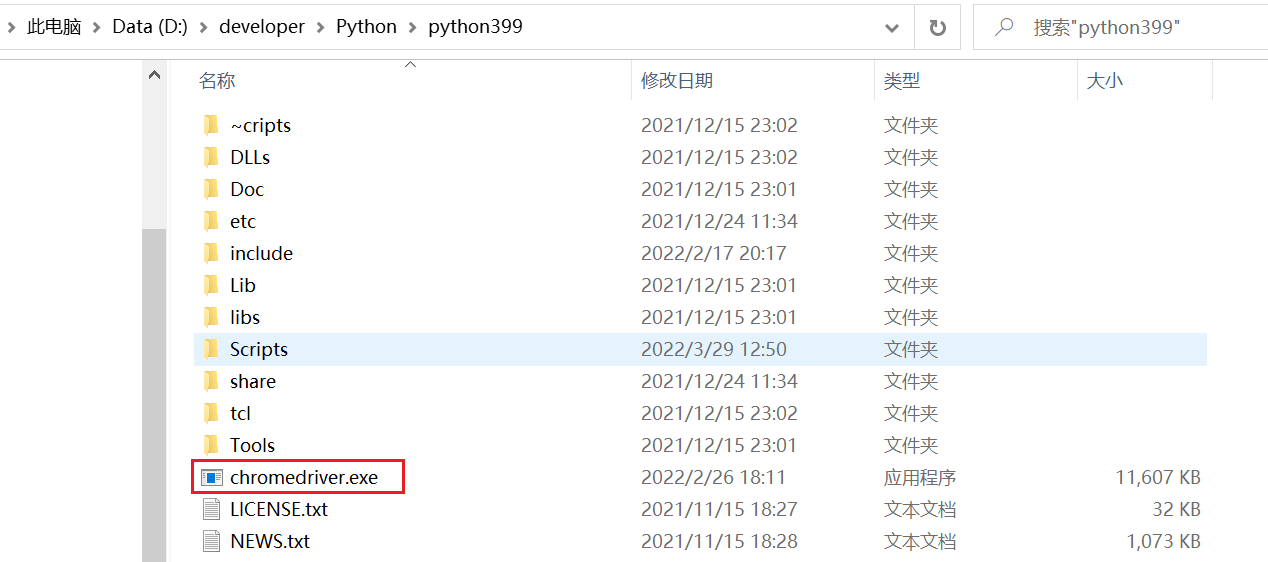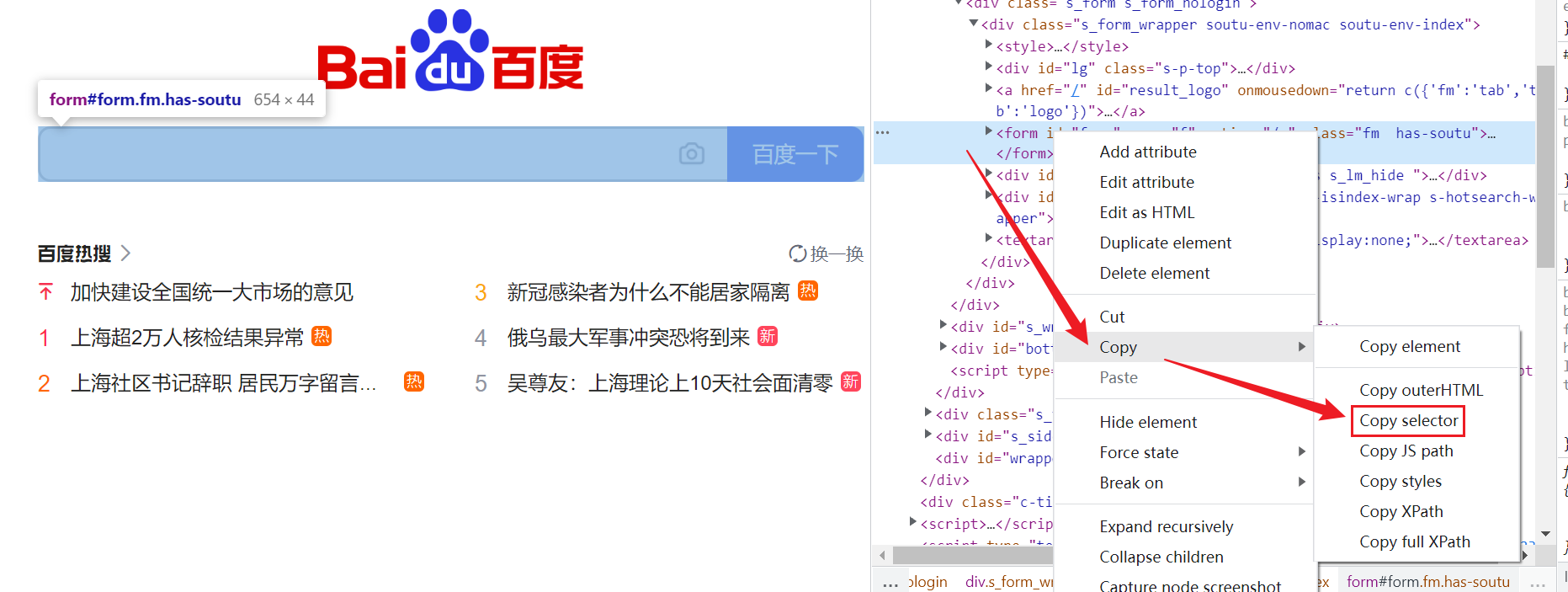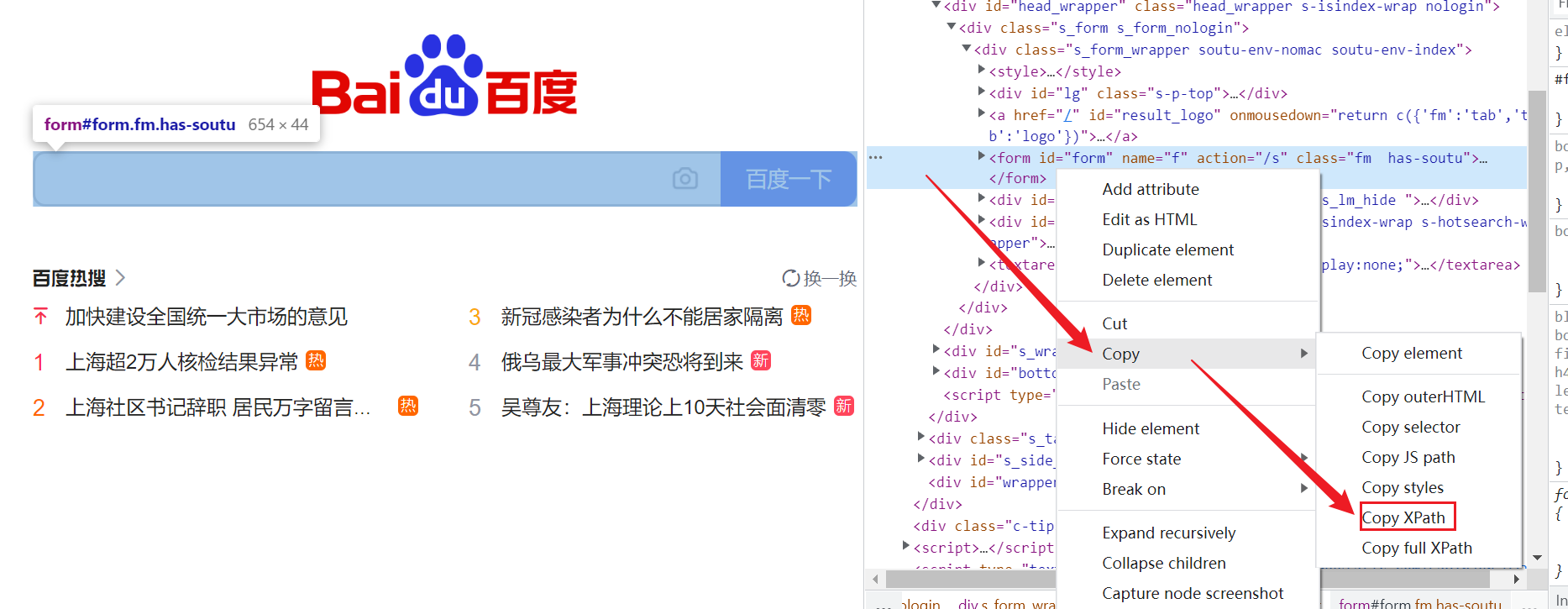1 简介
Selenium最初是一个自动化测试工具,Selenium可以驱动浏览器自动执行自定义好的逻辑代码,即通过代码完全模拟使用浏览器自动访问目标站点并操作,所以也可以用来爬虫。
本次教程使用Python3.9.9,谷歌浏览器版本 100.0.4896.75(正式版本) (64 位):

2 安装
-
安装selenium:
pip install selenium -
安装谷歌浏览器驱动,版本要与上面的浏览器版本对应(版本不一定完全一致,尽量一致),驱动下载链接

-
将下载好的驱动文件解压后放到python安装路径下,使其生效:

3 样例
爬取百度搜索结果:
1 | from time import sleep |
代码解读:
-
配置浏览器,当
co.headless = False时候有界面化(默认);当co.headless = True时为无头浏览器,也就是无界面化浏览器。 -
百度服务器响应存在延迟,所以很可能造成接下来的代码执行失败,因此执行
browser.implicitly_wait(30)。这样如果找不到元素,每隔半秒钟再去界面上查看一次, 直到找到该元素, 或者过了30秒最大时长。 -
利用chrome的f12开查找搜索框和搜索按钮的id:

根据ID定位有两种写法:
1
2browser.find_element_by_id('kw') # 已废弃
browser.find_element(by=By.ID, 'kw') # 推荐第一种写法会报warning:selenium弃用警告DeprecationWarning
1
2DeprecationWarning: find_element_by_* commands are deprecated. Please use find_element() instead
browser.find_element_by_id('kw').send_keys("python") # 输入框send_keys()方法可以在对应的元素中输入字符串;click()方法是点击该元素。 -
find_elements()返回的是找到的符合条件的所有元素,放在一个列表中返回;find_element()只会返回第一个元素。
4 定位元素
find_elements()返回的是找到的符合条件的所有元素,放在一个列表中返回;find_element()只会返回第一个元素。
4.1 id
1 | <div id="coolestWidgetEvah">...</div> |
1 | element = driver.find_element(by=By.ID, value="coolestWidgetEvah") |
4.2 class name
1 | <div class="cheese"><span>Cheddar</span></div><div class="cheese"><span>Gouda</span></div> |
1 | cheeses = driver.find_elements(By.CLASS_NAME, "cheese") |
4.3 tag name
1 | <iframe src="..."></iframe> |
1 | frame = driver.find_element(By.TAG_NAME, "iframe") |
4.4 name
1 | <input name="cheese" type="text"/> |
1 | cheese = driver.find_element(By.NAME, "cheese") |
4.5 link text
1 | <a href="http://www.google.com/search?q=cheese">cheese</a> |
1 | cheese = driver.find_element(By.PARTIAL_LINK_TEXT, "cheese") |
4.6 Partial Link Text
1 | <a href="http://www.google.com/search?q=cheese">search for cheese</a> |
1 | cheese = driver.find_element(By.PARTIAL_LINK_TEXT, "cheese") |
4.7 css selector
1 | <div id="food"><span class="dairy">milk</span><span class="dairy aged">cheese</span></div> |

1 | cheese = driver.find_element(By.CSS_SELECTOR, "#food span.dairy.aged") |
4.8 xpath
1 | <input type="text" name="example" /> |

1 | inputs = driver.find_elements(By.XPATH, "//input") |
5 鼠标动作链
有些时候,我们需要再页面上模拟一些鼠标操作,比如双击、右击、拖拽甚至按住不动等,我们可以通过导入 ActionChains 类来做到:
1 | #导入 ActionChains 类 |
6 页面等待
现在的网页越来越多采用了 Ajax 技术,这样程序便不能确定何时某个元素完全加载出来了。如果实际页面等待时间过长导致某个dom元素还没出来,但是你的代码直接使用了这个WebElement,那么就会抛出NullPointer的异常。
为了避免这种元素定位困难而且会提高产生 ElementNotVisibleException 的概率。所以 Selenium 提供了两种等待方式,一种是隐式等待,一种是显式等待。
隐式等待是等待特定的时间,显式等待是指定某一条件直到这个条件成立时继续执行。
6.1 显式等待
显式等待指定某个条件,然后设置最长等待时间。如果在这个时间还没有找到元素,那么便会抛出异常了。
1 | from selenium import webdriver |
如果不写参数,程序默认会 0.5s 调用一次来查看元素是否已经生成,如果本来元素就是存在的,那么会立即返回。
下面是一些内置的等待条件,你可以直接调用这些条件,而不用自己写某些等待条件了。
1 | title_is |
6.2 隐式等待
隐式等待比较简单,就是简单地设置一个等待时间,单位为秒。当然如果不设置,默认等待时间为0。
上面的样例就使用的这种等待方式。
1 | from selenium import webdriver |
